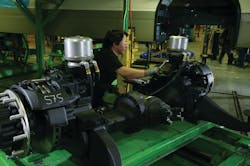When it comes to challenges in running, planning, operating and even supplying transit systems, one common topic follows each step — regulations.
U.S. and Canadian transit systems and infrastructure are subjected to regulations from the time a route is first envisioned or raw materials are first scooped out of the ground, to the delivery of the final product and the day-to-day operation of a line.
New rules set forth by the federal government are causing an additional burden on transit agencies in main part because of a lack of a long-term funding source.
Former deputy secrtary of the DOT John Porcari, who now works as senior vice president and national director of strategic consulting at Parsons Brinckerhoff, said in a two-year authorization bill there are five to six years’ worth of work and regulations packed into it, so DOT staff has to prioritize the most important regulations.
“There’s a lot more work under MAP-21 in particular terms that can’t be done in that two-year interval,” he said. “Along those lines, I think it’s very frustrating out there because full funding grant agreements used to mean just that. It was an arduous process that would take some time, but once you got it, you could take it to the bank..
A balance of state and federal rules
When the idea of heavy regulations comes up, the first state many think of is California. Known for its stricter air quality laws and regulations, transit agencies in this state have unique challenges trying to balance regulations while providing the most effective service as possible.
Jacklyn Montgomery, executive director of the California Association for Coordinated Transportation (CalACT), which represents smaller and more rural transit agencies in California, said many of the organization’s members are very concerned about a potential law set forth that would deem all transit vehicles become emissions-free because achieving such a standard would be very costly for small agencies.
Some politicians have said transit agencies would be able to use revenue generated under a state cap-and-trade law to purchase new equipment, but Montgomery said Gov. Jerry Brown has signaled he wants to use that money for the proposed bullet train and the legislation wouldn’t generate enough money.
“If CARB moves forward, it will lead to additional issues that will have to be dealt with the smaller agencies and CalACT members,” said Rick Ramacier, general manager of the Central Contra Costa County Transit Authority (County Connection) and chair of the CalACT Board of Directors. “They’re going to be extremely hard pressed if they can’t come together and do joint projects because of the sheer expense and technological knowledge needed because it could be really huge for some smaller and rural agencies.” We’re ironically in good shape at my agency,” Ramacier said. “We secured a clean fuel grant to electrify a trolley we run in one of our downtowns.”
More aggressive state regulations are also causing headaches for agencies trying to meet federal regulations. Ramacier said after California passed pension reform, transit agency worker’s unions decided it violated federal transit codes, so they went to the U.S. Department of Labor to object to all grant applications. The applications were held up for nearly a year and the issue is still unresolved, so agencies will have to wait as the issue makes its way through the courts.
Montgomery said agencies have become concerned because the Federal Transit Administration has been regulating via audits instead of going through the traditional process of changing rules where agency leaders give comment on how rule changes will impact them.
Ramacier echoed the sentiment, saying the FTA appears to be slipping in questions that are “backdoor changes” to regulations or longstanding interpretations of rules and applying them in different ways until the change then becomes the de facto rule.
“I think we hear a little more talk from agencies that at what point do you give up federal funds to avoid certain regulations,” Ramacier said.
One example California is dealing with in this area is route deviation in order to provide transit for people with disabilities using a fixed route buses, which deviate from their regular route when needed. The FTA has raised issue with this in California, Ramacier said, and smaller agencies in other parts of the country will be seeing this issue coming to them.
“The FTA has a new weird approach to that that I can’t fully articulate because I didn’t fully understand this,” Ramacier said. “And I can’t really point to any language in any existing regulations that bar that.”
Suppliers meet the same standards
Ray Melleady, managing director of North America for USSC Group, said changing regulations from the federal government generally take years to implement, but when it change comes, it’s generally driven from within the industry, so they can provide great benefits.
“From my viewpoint, I don’t view regulations as a problem in the industry,” he said. “I think regulations are important for improvements in safety and efficiencies and to provide uniformity. Seatbelts are a great example of that. We’ve had seatbelts available for years and generally we’re ahead of the regulations, but it drives uniformity and I think it makes us a better industry and a better market for providing better products and it provides a level playing field to the operators.”
Melleady said USSC Group does extensive testing on transit seating and make sure products not only meet, but exceed current regulations. By performing certain testing to exceed current standards, it allows the company to steer the regulations and not the other way around.
The use of seatbelts in mass transit has been a hot topic for years, but they remain a challenge given the unique nature of transit passengers whom oftentimes stand on a bus or only take short trips. Melleady said there’s also questions as to if customers will actually use the seatbelts if provided to them.
New regulations must be developed in a mindset mixed with reality and vision, Melleady said, and written in a framework of common sense. Stakeholders need to be engaged, funding needs to be addressed and education on the new rules must be addressed.
“People need to understand the intent and how compliance will be measured,” he said. “No one likes to play in a game without rules.“
Jean-Yves Vallee, director of product planning for Nova Bus, said bus manufacturers need to be aware of regulations in Canada and the U.S., but most Canadian rules related to vehicle safety and environmental standards are very aligned so there isn’t a big issue making products fitting federal guidelines in both countries.
Vallee said changes in diesel emissions regulations in recent years have forced manufacturers to find ways to step up products to meet these new requirements. With stricter standards set down in 2007, 2010 and 2013, it means there’s been a lot of work for both engine makers and bus companies working to meet the new regulations.
“The engine we buy for the U.S. market is approved for the Canadian market as well, so in terms of the regulations, that’s no giving us a headache, but it costs a lot of money,” he said. “Every time we do an emissions change, we have to do testing and validation of the suppliers and it’s quite expensive.
Recent emissions regulations focused on reducing particulate matter and carbon monoxide in diesel engines, but Vallee said the new round of changes coming in 2017 will focus on a reduction of greenhouse gases. This means increased efficiencies for buses, which Vallee said will be a challenge.
Vallee said in the wake of some people getting injured by flip seats on buses, there is the potential of some new regulations coming down to address safety concerns, however, it’s a tricky issue for the industry to handle given many bus passengers are standing and city buses are generally designed to operate at low speeds.
“This whole flip seat thing is kind of a big question,” he said. “Ok, that’s fine, somebody got hurt. That happened, but what about the people standing? In an accident they will get knocked down, of course that will happen, but how do you protect against that? Do you make it illegal to have people standing on an intercity bus? To carry the same amount of people, you would need more buses in the fleet and that would be very expensive for operators.”
Buy America issues
Buy America and Buy Canadian rules can present some challenges for bus makers like Nova, because it means the company has to find suppliers on both sides of the boarder in order to make sure orders are complaint. However, the rules also allow the company to get a deep list of suppliers, which allows them to meet compliance rules easier.
“We have leeway on both sides to switch suppliers it actually introduces a form of competition from suppliers we can buy from,” Vallee said.
Buy America compliance has been a little more challenging for bus companies, Vallee said because of the cheap cost of electronics coming from Asian markets and technology from Germany. But the biggest issue comes in steel suppliers because if Nova buys U.S. stainless steel, takes it to Canada and turns it into bus parts, it’s no longer credited as Buy American complaint.
But if the company buys Chinese steel and brings it into the country, it is considered Buy American compliant.
“It’s kind of a shame,” Vallee said. “We’re actually gung ho on encouraging to buy U.S. steel, but we get no extra credit on that while at the same time you may have someone buying steel from China, welding it in the U.S. and getting the Buy America advantage over us and we find this unfair.”
About the Author
Joe Petrie
Associate Editor
I came to Mass Transit in 2013 after spending seven years on the daily newsbeat in southeastern Wisconsin.
Based in Milwaukee, I worked as a daily newspaper reporter with the Waukesha Freeman from 2006-2011, where I covered education, county and state government. I went on to cover courts for Patch.com, where I was the main courts reporter in the Metro Milwaukee cluster of websites.
I’ve won multiple awards during the course of my career and have covered some of the biggest political events in the past decade and have appeared on national programs.
Having covered local government and social issues, I discovered the importance of transit and the impact it can have on communities when implemented, supported and funded.

